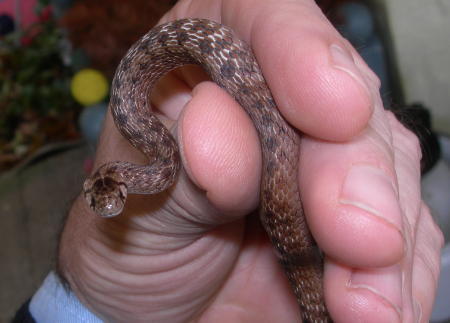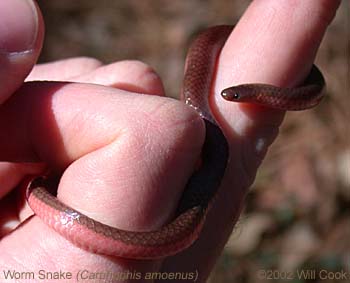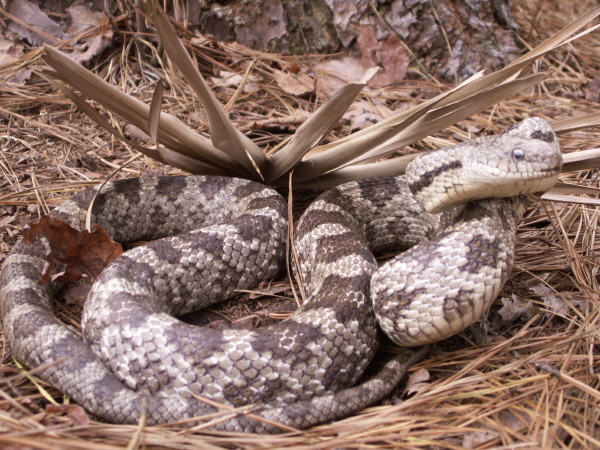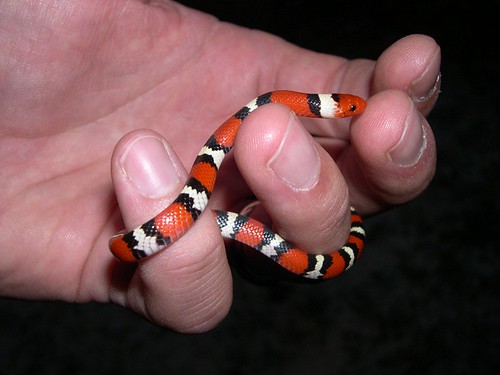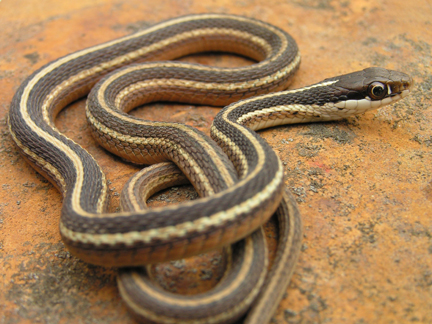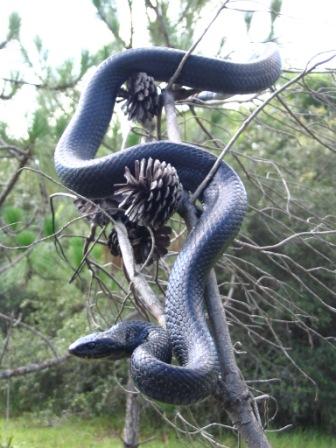repoman34
Banned
It's officially hot outside now, and the snakes are moving around quite a bit. I always see people posting threads wanting a snake identified, so I've decided to post a thread just for that purpose. I'll try to cover all of the GA native snakes here so everyone can have a reference. Maybe this will help keep someone here from getting bit by a snake they shouldn't have been bothering.
I'll start with the venomous snakes. Georgia has 4 main types of venomous snakes. Copperheads, Rattlesnakes, Cottonmouth (water-moccassin), and Coral snake. Some of these do have more than one species here. I'm going to try to post a pic, and a brief description of each one;
Southern Copperhead
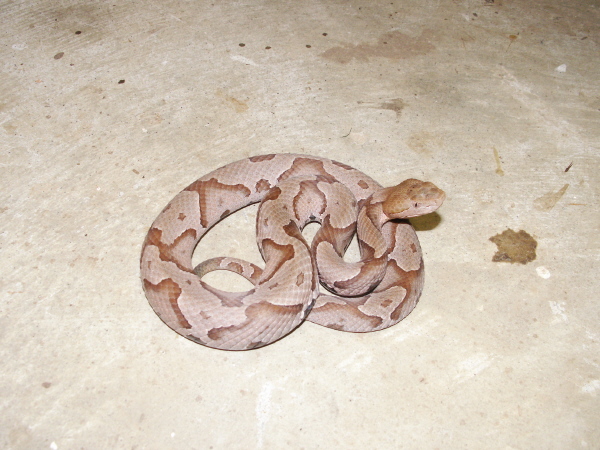
Copperheads are one of the most common venomous snakes we have here. Coloration may very from very light, to very dark depending on the snakes age, gender, and habitat. These snakes usually stay pretty short, around 2-3 feet long, but can be bigger. They like to hang out in the leaves on the ground, around rocks, rivers, streams, etc. Bites from these snakes usually occurs when someone steps on one because they didn't see it. In my opinion, the Copperhead has the best camouflage of any snake we have here. They are usually a light tan color, with dark, reddish brown hourglass pattern all over them. At a glance, the coloration and pattern is close enough, that a lot of people will mistake these for a non-venomous Banded Water Snake, and vice-versa. Regardless of popular belief, these are actually not aggressive snakes even though they are venomous. If you see one, simply move around it at a safe disatnce, and let it be.
Cottonmouth (Water Moccassin)


I've posted 2 pictures of the Cottonmouth to show you that the coloration of these snakes can vary greatly. Some are a dark brown or olive color with a defined black pattern on them, others can be solid brown, or solid olive. Juvenile Cottonmouth colors can vary even more than that. Cottonmouths usually grow from 3-4 feet long, but can be bigger. Last time I checked, the state record for a cottonmouth was somewhere around 7 feet long. They have fat bodies, and when threatened will coil and puff their bodies up even bigger. They'll open their mouth wide and generally stay put in that position, unless provoked further. These snakes love to hang out close to the waters edge, under rocks, roots, logs, etc, and in tree branches. I have seen these snakes in tree branches that were 8-10 feet off the ground. Always keep your eyes open for them. These snakes produce an extremely nasty bite.
Eastern Diamondback Rattlesnake

The Eastern Diamondback Rattlesnake is North America's largest venomous snake. It feeds on rabbits, squirrels, rats and birds. This snake is most likely to be found in pine flatwoods and fallow, brushy fields bordered by forests. The Eastern Diamondback Rattlesnake is considered by some people the most dangerous snake found in the southeastern U.S.; however, it is becoming increasingly rare. Specimens have been captured as a large as 8 feet long and weighing 15 pounds, but the average size is about 5 feet. Between 7 and 18 young are born in August or September. Fortunately this snake is unlikely to strike at a person unless provoked.The sound of a rattlesnake is loud and distinctive - easily audible up to 30 feet away in an outdoor setting.
Timber Rattlesnake (aka: Canebrake)

Timber rattlesnakes, which are called canebrake rattlesnake in the Coastal Plain of the Southeast, are large, heavy bodied snakes with the characteristic rattles on the end of the tail. Adults range from 30-60 in (76-152 cm) with the record being more than 6 feet (183 cm) long. Canebrakes are usually gray and may even have a pink hue and a pinkish, yellow, orange, or brown stripe running the length of the back. Timber rattlers are typically more brown or yellowish and may even be black. Both forms have solid black tails that appear almost velvet and black chevrons on the back and sides with the point of the (V) pointing forward. The babies are miniatures of the adults but are usually a lighter gray and have only a single button (rattle) on the tip of the tail at birth. Males get larger than females.
canebrake rattlesnakes have a wide distribution in the eastern United States but the species is absent from most of Florida. This snake occurs in a wide variety of terrestrial habitat including lowland cane thickets, high areas around swamps and river floodplains, hardwood and pine forests, mountainous areas, and rural habitats in farming areas. Canebrakes are active during both day and night but spend the majority of their time coiled in ambush positions ready to capture prey.
Pygmy Rattlesnake

The Dusky Pigmy Rattlesnake are small heavy bodied snakes. They are usually grey or a grayish brown with dark blotches, and a gold or orange stripe that runs down the back of the snake. Some are very light in coloration while some that are found in Florida are very dark. In several counties in northern South Carolina and southern North Carolina the Carolina Pigmy Rattlesnakes are sometimes very bright red. The juveniles of both subspecies look identical to the adults, except for they have a sulfur yellow tail. The average length for a Carolina Pigmy is between 14-20 inches. The longest recorded was just over 2ft. The average length for a Dusky Pigmy Rattlesnake is 20 inches and the longest record is at 31 inches. Pigmy Rattlesnake lives in boggy wetlands, coastal pinewoods, scrub oak inhabitant of sandy substrates. Farther inland they can be found in the both pine and open, mixed woodlands, near water sources and in driers areas. The Dusky Pigmy Rattlesnake is mostly found in the Longleaf Pine/Saw Pine habitat that is common in Florida, southern Georgia, and southern Alabama. The can also be found in bottomland hardwood forest, wet saw-grass, dry hammocks, and the prairies.
Coral Snake
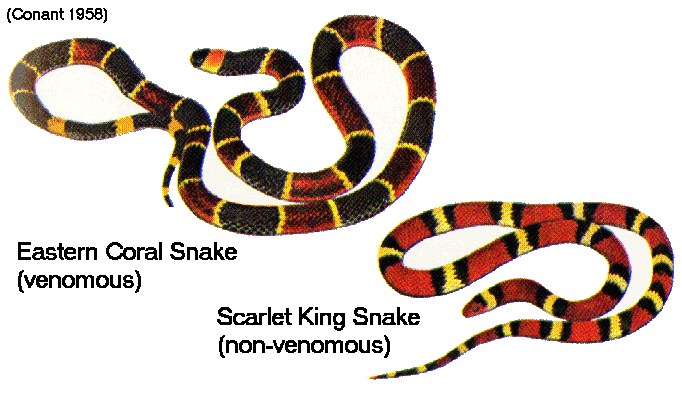
You'll probably never see one of these snakes in the wild; they generally stay away from people. If you do encounter one, they aren't at all agressive, and they actually have trouble trying to inject venom into a human due to the fact that they have very small fangs that are fixed into the back of their mouth, not the front like all of our other venomous snakes. That doesn't mean that they can't get you though, so handling them isn't recommended. They usually grow to be about 2 1/2 feet long and stay pretty slender. They DO NOT have a diamond shaped head like our other venomous snakes. I posted the pic above to show how easily you can confuse a Coral snake with a non-venomous Scarlett King Snake. The old saying goes " Red on yellow; kill a fellow. Red on black; friend of Jack".
I'll start with the venomous snakes. Georgia has 4 main types of venomous snakes. Copperheads, Rattlesnakes, Cottonmouth (water-moccassin), and Coral snake. Some of these do have more than one species here. I'm going to try to post a pic, and a brief description of each one;
Southern Copperhead

Copperheads are one of the most common venomous snakes we have here. Coloration may very from very light, to very dark depending on the snakes age, gender, and habitat. These snakes usually stay pretty short, around 2-3 feet long, but can be bigger. They like to hang out in the leaves on the ground, around rocks, rivers, streams, etc. Bites from these snakes usually occurs when someone steps on one because they didn't see it. In my opinion, the Copperhead has the best camouflage of any snake we have here. They are usually a light tan color, with dark, reddish brown hourglass pattern all over them. At a glance, the coloration and pattern is close enough, that a lot of people will mistake these for a non-venomous Banded Water Snake, and vice-versa. Regardless of popular belief, these are actually not aggressive snakes even though they are venomous. If you see one, simply move around it at a safe disatnce, and let it be.
Cottonmouth (Water Moccassin)


I've posted 2 pictures of the Cottonmouth to show you that the coloration of these snakes can vary greatly. Some are a dark brown or olive color with a defined black pattern on them, others can be solid brown, or solid olive. Juvenile Cottonmouth colors can vary even more than that. Cottonmouths usually grow from 3-4 feet long, but can be bigger. Last time I checked, the state record for a cottonmouth was somewhere around 7 feet long. They have fat bodies, and when threatened will coil and puff their bodies up even bigger. They'll open their mouth wide and generally stay put in that position, unless provoked further. These snakes love to hang out close to the waters edge, under rocks, roots, logs, etc, and in tree branches. I have seen these snakes in tree branches that were 8-10 feet off the ground. Always keep your eyes open for them. These snakes produce an extremely nasty bite.
Eastern Diamondback Rattlesnake

The Eastern Diamondback Rattlesnake is North America's largest venomous snake. It feeds on rabbits, squirrels, rats and birds. This snake is most likely to be found in pine flatwoods and fallow, brushy fields bordered by forests. The Eastern Diamondback Rattlesnake is considered by some people the most dangerous snake found in the southeastern U.S.; however, it is becoming increasingly rare. Specimens have been captured as a large as 8 feet long and weighing 15 pounds, but the average size is about 5 feet. Between 7 and 18 young are born in August or September. Fortunately this snake is unlikely to strike at a person unless provoked.The sound of a rattlesnake is loud and distinctive - easily audible up to 30 feet away in an outdoor setting.
Timber Rattlesnake (aka: Canebrake)

Timber rattlesnakes, which are called canebrake rattlesnake in the Coastal Plain of the Southeast, are large, heavy bodied snakes with the characteristic rattles on the end of the tail. Adults range from 30-60 in (76-152 cm) with the record being more than 6 feet (183 cm) long. Canebrakes are usually gray and may even have a pink hue and a pinkish, yellow, orange, or brown stripe running the length of the back. Timber rattlers are typically more brown or yellowish and may even be black. Both forms have solid black tails that appear almost velvet and black chevrons on the back and sides with the point of the (V) pointing forward. The babies are miniatures of the adults but are usually a lighter gray and have only a single button (rattle) on the tip of the tail at birth. Males get larger than females.
canebrake rattlesnakes have a wide distribution in the eastern United States but the species is absent from most of Florida. This snake occurs in a wide variety of terrestrial habitat including lowland cane thickets, high areas around swamps and river floodplains, hardwood and pine forests, mountainous areas, and rural habitats in farming areas. Canebrakes are active during both day and night but spend the majority of their time coiled in ambush positions ready to capture prey.
Pygmy Rattlesnake

The Dusky Pigmy Rattlesnake are small heavy bodied snakes. They are usually grey or a grayish brown with dark blotches, and a gold or orange stripe that runs down the back of the snake. Some are very light in coloration while some that are found in Florida are very dark. In several counties in northern South Carolina and southern North Carolina the Carolina Pigmy Rattlesnakes are sometimes very bright red. The juveniles of both subspecies look identical to the adults, except for they have a sulfur yellow tail. The average length for a Carolina Pigmy is between 14-20 inches. The longest recorded was just over 2ft. The average length for a Dusky Pigmy Rattlesnake is 20 inches and the longest record is at 31 inches. Pigmy Rattlesnake lives in boggy wetlands, coastal pinewoods, scrub oak inhabitant of sandy substrates. Farther inland they can be found in the both pine and open, mixed woodlands, near water sources and in driers areas. The Dusky Pigmy Rattlesnake is mostly found in the Longleaf Pine/Saw Pine habitat that is common in Florida, southern Georgia, and southern Alabama. The can also be found in bottomland hardwood forest, wet saw-grass, dry hammocks, and the prairies.
Coral Snake

You'll probably never see one of these snakes in the wild; they generally stay away from people. If you do encounter one, they aren't at all agressive, and they actually have trouble trying to inject venom into a human due to the fact that they have very small fangs that are fixed into the back of their mouth, not the front like all of our other venomous snakes. That doesn't mean that they can't get you though, so handling them isn't recommended. They usually grow to be about 2 1/2 feet long and stay pretty slender. They DO NOT have a diamond shaped head like our other venomous snakes. I posted the pic above to show how easily you can confuse a Coral snake with a non-venomous Scarlett King Snake. The old saying goes " Red on yellow; kill a fellow. Red on black; friend of Jack".

